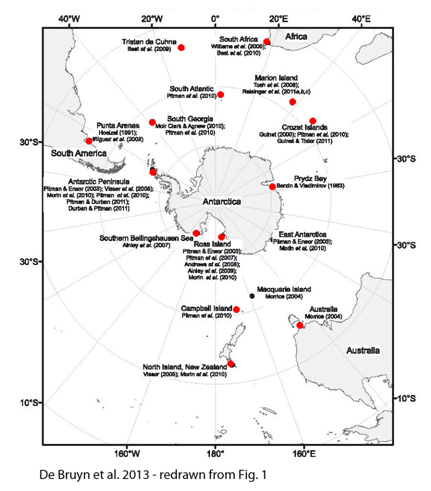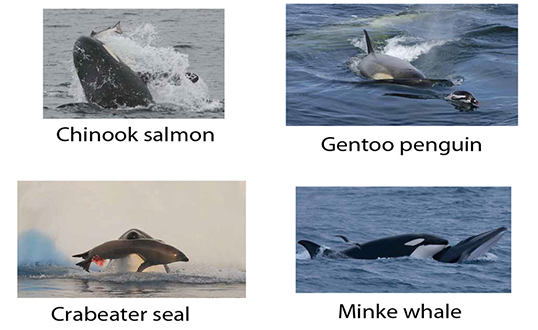Killer whale biology
Taxonomy, distribution and numbers
Killer whales (Orcinus orca) belong to the order Cetacea, the sub-order Odontoceti, and the family Dephinidae. They are a cosmopolitan species with a worldwide distribution, although they are observed more frequently in areas of high productivity, at high latitudes, and along the boundaries of the continental shelves (within 800 Kim). They are observed frequently in southern South America, South Africa, Australia, New Zealand, Alaska, and northern Europe. At low latitudes they are observed mostly in California, Hawaii, and Galapagos.

The main killer whale populations of the Southern Hemisphere
The current worldwide population of killer whales is estimated at 50000 individuals, although accurate numbers are available for just few populations, and there are no estimates for large areas, in particular in the southern hemisphere. All together, the above estimate should be considered tentative and very likely conservative. It is supposed that at least 25000 killer whales live at latitudes above 60 degrees.
Size and maturation
Killer whales are about 3.5-4 meters long at birth, and up to 4.5 meters at weaning. Adult males grow up to 9 meters, while maximum size for females is about 7.7 meters. They can weigh up to 7 tons.

Killer whale sexual dimorphism
Ecology
Killer whales are top predators that move extensively between coastal waters and open ocean. They have been observed preying on a very large range of species, from fishes to other whales. There is often a clear specialization in feeding habits, which is in part related to average size of individuals. Maximum dive depth is about 500 meters.
In the northern hemisphere various local populations have been shown to be preying upon a single species of fish, like herring or bluefin tuna. In the Northeastern Pacific killer whales prey most on seals, and occasionally on baleen whales. In the Antarctic seas there are populations taking mostly minke whales, other specialized in taking seals, and other feeding mostly on fish species. Killer whales are estimated to eat up to 4% of their body weight every day, a true killer appetite.

A sample of killer whale preys
In the past, killer whales were commercially exploited for oil and meat. Now, although there is no extensive commercial taking, meat is still eaten in some countries of the Far East.
Currently, killer whales are mostly threatened by exploitation of their preys, general degradation of their living habitat, and accumulation of contaminants in the oceans. Global climate change is of great concern because of its effect on many killer whales prey species. The local populations with a very specialized fish diet are particularly at risk, due to competition with commercial fisheries. Locally, killer whales are often perceived as competitors by fishermen, and intentional shooting is known to occur, in particular at low latitudes.
The species is included in the CITES Appendix II list, and various local populations are considered threatened and subject to special conservation measures.
Life cycle
Killer whales can live up to 50-70 years. Calving happens about every 3-4 years, after a gestation of about 17 months. There is no definite breeding or calving season. Lactation lasts about 12 months, and weaning begins when the calf is about 4 to 4.5 meters long, but the calf can stay with the mother for up to 2 years more. Sexual maturity is reached around 20 years of age in both sexes.
Social behaviour and hunting
Killer whales usually are observed in groups called "pods", with an average size of 6 individuals, but larger groups are occasionally observed (up to 40 individuals together). Group composition differs among populations. In the northern Pacific average composition is 19% mature males, 40% mature females, and 41% of calves and juveniles. In Alaska the average group includes 19% of mature males, 27% of calves and juveniles and rest of females and subadult males.
The mating system is likely polygynous, with some males controlling access to females in oestrus, but no definitive data is available on the matter. Killer whales have a rich communication system, which permits the maintenance of groups with complex social relationships. Different local populations show different vocalization patterns and, therefore, are supposed to have well defined dialects.
Killer whales hunt in groups, and are able to coordinate attacks, being very efficient in preying upon species of very different size and habits. They show intentional stranding hunting techniques, which permit them to prey on resting sea lions. These techniques are a good example of complex cultural transmission, because young individuals need a long training by the mothers before becoming effective in applying them. Also the predation of other whales requires a long training, because of the complexity of separating large whale calves from their mothers.
Killer whales, like many other cetaceans, use echolocation while under the water. They emit click trains, and use the reflected sound waves to determine distance, size, and even composition, of objects and other animals.
